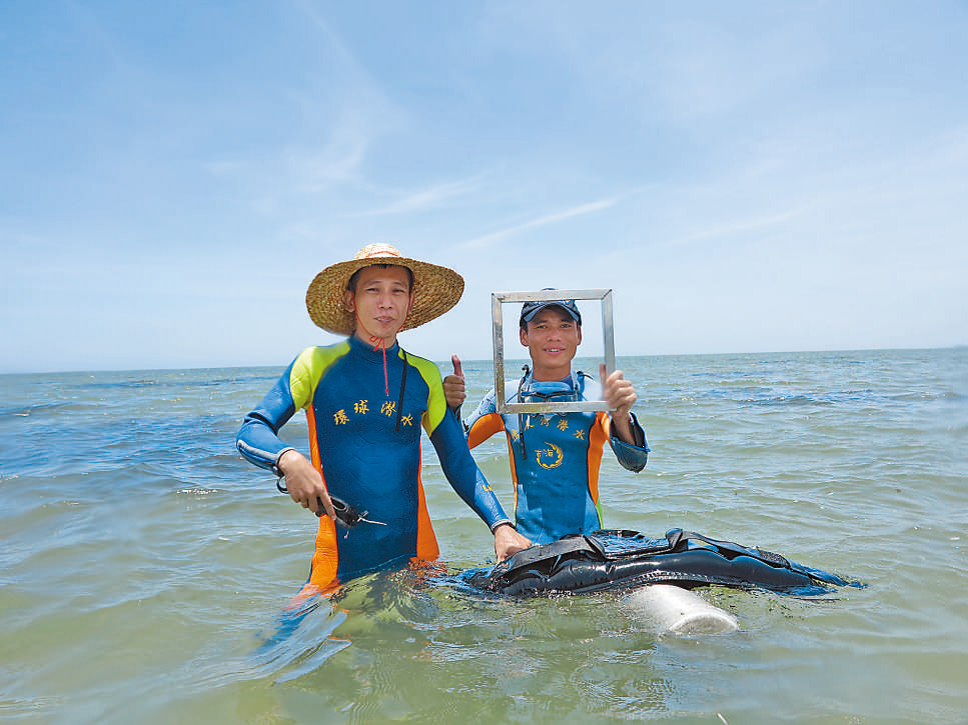In 2018, an institute of marine ecology under Hainan Academy of Ocean and Fisheries Sciences in south China's Hainan Province was given a novel task – planting seagrasses on the ocean floor.

Researchers of the institute restore seagrass meadows. (Photo courtesy of an institute of marine ecology under Hainan Academy of Ocean and Fisheries Sciences)
This was because earlier that year, Hainan decided to restore eco-environment in Qinglan port, Wenchang city, in the northeast corner of Hainan Island, which was previously destroyed by channel expansion and sea reclamation. The task of restoring seagrass resources was one part of the restoration projects.
In recent years, land-based pollution and a large amount of suspended sediments from offshore projects have entered the sea, causing natural wetlands to diminish and seagrass beds to vanish at a faster pace.
Without seagrass beds, the basic "vegetation" under the sea, the sea floor was turning into a desert.
"The loss of seagrass beds has exerted an enormous impact on marine ecology," Wu Zhongjie, director of the institute told the People's Daily.
"This is because seagrass beds boost the circulation of marine life in the ecological environment, while purifying ocean water by absorbing the sediments," Wu added.
Seagrass beds in the channel of Qinglan port in Gaolong Bay have suffered continuous degradation these years. According to local fishermen, seagrasses were fairly lush in the 1980s. One-meter-long enhalus acoroides could be seen everywhere while Thalassia hemprichii sprawled in shallow waters.
However, the degradation of the seagrass beds has caused the loss of shelters of many fish, biodiversity loss and decrease in the species density. The fishermen now find it more difficult to catch the fish in nearshore waters than before.
Later, the decision to restore a barren area of the sea floor in Gaolong Bay was made according to a research, for the area was covered mainly by coral reef debris and sediments.
The institute tried different species of seagrasses, such as Enhalus acoroides, Thalassia hemprichii and Cymodocea rotundata, and tested and analyzed their survival rate and growth. Then Enhalus acoroides and Thalassia hemprichii were chosen as the species for trial based on a comprehensive analysis.
The next step was to decide how to cultivate grass. The institute came up with a two-prong method.
One part is about transplantation. The researchers first planted the seagrasses in different man-made carriers made of coconut shell, clay and bamboo, and then placed these carriers with seagrasses in the barren area deep down the sea.
The other part of the method was focused on restoring ecological environment in a more natural way. The researchers planted the seeds of Thalassia hemprichii in the sea bed of nearshore areas, and applied fertilizer to them. Then the seagrasses grew spontaneously.
Moreover, China's desert control method – grid of straw squares, inspired the researchers to make a similar version, which consisted of fishing nets and iron plates.
The nets, together with the grid of iron squares placed on it, could hold the sea bed together well enough to resist the currents in the sea, enable the sediments to precipitate, and capture the nutrition. As a result, both the sea floor and the seagrasses were stabilized.

A researcher of the institute checks the growth of Enhalus acoroides, which is transplanted on the sea bed. (Photo courtesy of an institute of marine ecology under Hainan Academy of Ocean and Fisheries Sciences)
"When the sea bed is fully recovered, the nets and grid will be disassembled and recycled. The recovered seagrasses will emerge in an orderly pattern as they grow. Little by little, vast stretches of seagrass beds will be formed," Chen Shiquan, a key member on the research team, explained to the People's Daily.
"Seagrass beds serve as a natural ecological barrier for coastal areas. In the coral reef-mangrove-seagrass complex, often been described as one of the most biologically diverse and productive systems in the world, seagrasses support and link the other two," said Chen.
Chen added that long stretches of seagrass meadows could weaken wave energy and current energy and stabilize sea bed, which play an important part in consolidating the sea bed and maintaining the coastline.
The institute announced in March that in the one-mu pilot area (1 hectare is 15 mu), the average survival rate of Thalassia hemprichii exceeded 56 percent, with an average coverage rate above five percent.
The results of Enhalus acoroides were even better, with an average survival rate exceeding 89 percent, and an average coverage rate above 22 percent.
In the next month, ecological restoration in Qinglan Port passed a third-party evaluation.
"Seagrass meadows, a typical eco-system in tropical ocean, provide marine life with shelters, nutrition, and nurseries. They are also the gene pool and home to rich fishery resources. The successful restoration carries great significance for ecology," Chen remarked.
A diver cleans a fishing net at Wuzhizhou Island Scenic Area's marine ranch in Sanya, South China's Hainan province, ...
Hainan province has established a national park research institute, issuing invitations to top experts, especially pr...